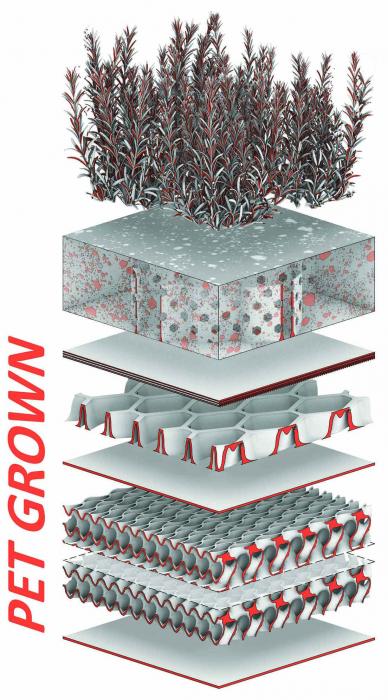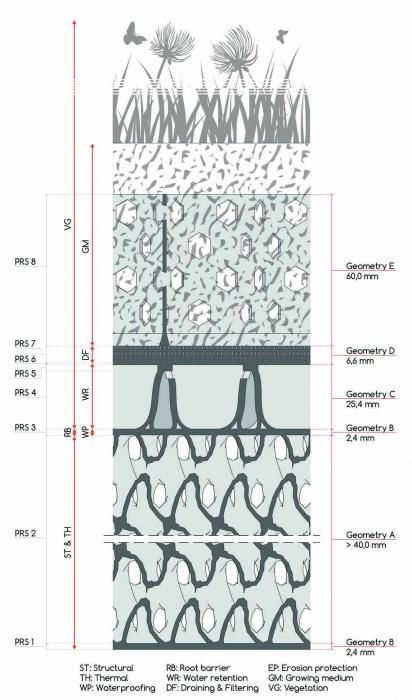I. SUMMARY INFORMATION
Project
267621
Status
Submitted
Award category
Buildings renovated in a spirit of circularity
You want to submit
NEW EUROPEAN BAUHAUS RISING STARS : concepts or ideas submitted by young talents (aged 30 or less)
Project title
PET GROWN
Full concept/idea title
A self-sustaining, mono-material and multi-functional green roof module (Msc thesis)
Description
The building industry currently stands as one of the most environmentally harmful industries. Even sustainable structures, like green roofs, are part of this harm. PET GROWN proposes a solution to this problem. It combines modern technologies to design and produce green roof structures which integrate all the essential functions and are made only out of rPET, an accessible material with a circular lifespan. Let's start building fully recyclable green roofs!
Where is your concept/idea being developed or intended to be implemented in the EU?
Netherlands
South Holland
-
Rotterdam
-
II. DESCRIPTION OF THE PROJECT
Please provide a summary of your concept/ idea
PET GROWN is part of a larger project that aims to combine computational design and additive manufacturing, to produce a mono-material tiny house out of the recycled polyethylene terephthalate (rPET); a widely used thermoplastic. This project focuses on the roof of the house, traditionally a multi-material construction with high technical requirements. Of the different types of roof systems, a flat green roof is selected to be designed, because of its potential superiority in sustainability. By replacing the usual multi-material green roof with a structure from a single recyclable material, the path to 100% circular building is paved.
More specifically in PET GROWN capitalizes on the shaping flexibility of rPET and the advantages of digital manufacturing to achieve that. One of the most important material layers that affect both the structure of the green roof and the survival of the plants is the growing medium. From the different types, a soil-based one is selected due to its efficiency. Based on that the functional layers of PET GROWN are defined as follows: structural, thermal, filtering and draining, erosion protection, growing medium and vegetation. All the above functions, except the two last ones, are combined in five geometries based on their shaping demands and their relative position. Geometry A, which integrates the thermal and structural layer, is followed by geometry B, which integrates the root barrier, the waterproofing layer and the bottom part of the water retention layer. Geometry C serves as the rest of the original water retention layer. Finally, geometry D is a combination of the filtering and draining layers, while geometry E acts as the erosion protection layer.
In the end PET GROWN is a green roof system that consists of two natural elements; an 8 cm thick substrate layer and a vegetation layer, and a 3d-printed rPET structure. The total height of the structure is a minimum of 80.6cm thick, (dependent on the structural requirements).
Please give information about the key objectives of your concept/idea in terms of sustainability and how these would be met
PET GROWN contributes to sustainable development by positively contributing to environmental, social and economical factors associated with building construction.
Every year the building industry uses approximately 40% of the world's energy and material flow and constitutes up to 30% the total generated waste. Most of the used materials seem to be recycled. However, research shows that most of the materials are downcycled, and consequently, the demand for high quality material in the building sector is not reduced. PET GROWN is a proposed solution to this problem, since only one material is used. This is the most common type of plastic in the world, and it can be upcycled almost infinitely. As such, energy and material demand of the green roof will be reduced dramatically for the following reasons. At first because no energy will be spent in the disassembling of the multi-material roof structures. Secondly, because the mass-recycling of only one material will increase the efficiency of the recycling process. And thirdly because very limited waste will be produced. This way, buildings will have an active role in expanding the circular economy.Moreover, the green roof will actively contribute to sustainable developments by reducing the energy consumption of the buildings and adding to the biodiversity of the built environment.
Furthermore, rPET is a material that can be found everywhere at a very low cost, a fact that makes PET GROWN accessible to people with different financial backgrounds.
Last but not least, the use of 3d-printers for the production of PET GROWN profits the community in a number of ways. Hazardous and non-ergonomic building construction techniques are replaced by digital fabrication. Thus, workers benefit from safer work conditions. Also, the use of 3d-printers in developed countries will relieve the labor shortage in the construction industry, a sector in which often suffers from a shortage of workers difficulties associated with the industry.
Please give information about the key objectives of your concept/idea in terms of aesthetics and quality of experience beyond functionality and how these would be met
Aesthetics have not been the driving parameters for the development of PET GROWN. Instead, aesthetics emerge from the main two design criteria, functionality and 3d-printability. Due to the above reason the design of rPET is characterized by simplicity. As a skin element of a building two faces are visible to the user: the roof and the ceiling. The roof enhances the experience of the users by importing green spaces in the built environment. The user can create their own garden and reconnect to nature. As for the ceiling, PET GROWN lends itself in multiple design approaches. rPET is a high-quality material that can be found in various colors and has high shaping flexibility, a fact that allows PET GROWN to adjust to the aesthetics of each building and the taste of each habitant.
Please give information about the key objectives of your concept/idea in terms of inclusion and how these would be been met
PET GROWN meets inclusion in three ways from design, manufacturing to choice of materiality.
Regarding design, a parametric tool is developed that allows the user to influence the final product based on their need. For instance, the user can define the height of the growing medium that is essential for the selected vegetation and the environmental conditions of the area, and the tool will use all the related geometries to ensure the successful function of the green roof. Or, in the case of an existing roof with existing functions, the final design can be adjusted by removing the geometries that are related to these functions. In this way, the existing building stock vsn live longer and come up to speed with sustainability standards. Of course, all these would not be feasible without the manufacturing flexibility of 3d-printing, in which the production cost remains the same regardless of the variations of the design.
Regarding manufacturing, a 3d-printer is essential to produce PET GROWN. Although it seems to be an advanced machine, low-cost and self-built 3d-printers are available in the market and with some configurations, they are capable of printing large pieces. Another way of getting a 3d-printer is supplying a robotic arm and adding a plastic extruder as end-effector. Robotic arms are increasingly more affordable, since there are many low-cost old models available from the industrial sector that are suitable.
Also, rPET is a material that can be found at a low price or even supplied by the user. There are many examples of startups in developing countries that produce rPET filament or pellets for 3d-printing by recycling the material gathered from landfills.
To summarize, the fact that PET GROWN is designed by a parametric tool and manufactured using an accessible material by using affordable technology, paves the way for non-experts to be able to construct their own buildings.
Please explain the innovative character of your concept/ idea
PET GROWN is innovative in three ways, the materiality, the design approach and the manufacturing process.
rPET is not commonly used in the building industry due to its sensitivity to high temperatures and UV radiation. Most of the time they are coated or combined with other materials to ensure their efficiency, thereby increasing the energy and time needed to recycle them. However, PET GROWN combines rPET with natural materials, like vegetation , increasing the life span of rPET while maintaining its recyclability, since the separation of rPET from the natural layers is not an energy and time demanding procedure.
The mono-material structures have been noticed to be efficient in nature, but these structures until recently were quite complex to be manufactured. However, recent innovations in 3d-printing have unlocked the production of such structures. PET GROWN is such an example. It has high shaping demands and to produce it, it was essential to discover innovative ways to translate the intended design into a physical object. For example, for each geometry multiple shapes were developed and evaluated based on 3d-printability and functionality, and the most efficient one was chosen for further design integration. In this way, functionality and manufacturing advantages and limitations are considered in tandem in the initial stage of the design to achieve an optimized system. Such a design approach is new, and in the future will force designers to rethink the shape of common building components.
The design to manufacturing procedure of PET GROWN is based on fundamentals of the 4th industrial revolution, in which social parameters are communicated to the physical world in real time through the digital environment. In the case of PET GROWN the spatial and social needs of the user are converted into a final product through digitalization of both design and manufacturing procedure. In this way the user has real-time influence on the production of the project.
Please detail the plans you have for the further development, promotion and/or implementation of your concept/idea, with a particular attention to the initiatives to be taken before May 2022
This project could be characterized as the primary stage of research on mono-material building components. Hence, there are several worthy research subjects.
Regarding PET GROWN, to achieve its efficiency it is important to continue following the research by design approach. Thus, the first step would be to 3d-print large scale physical prototypes and test them over an extended period. In this way, important information regarding the design improvement will be gathered. For example, information can be analyzed regarding the resistance of rPET to root penetration and how this can be improved through design. Furthermore, a higher integration between the functional layer can be investigated, this way material consumption and the long printing time can be reduced. Finally, it would be interesting to research the feasibility of other mono-material green systems in building construction, such as walls and fences. As such this investigation aims to support not only the application of the circular economy to building construction, but also the integration of nature with the built environment.
III. UPLOAD PICTURES
IV. VALIDATION
By ticking this box, you declare that all the information provided in this form is factually correct, that the proposed concept/idea has not been proposed for the New European Bauhaus Rising Stars Awards more than once in the same category.
Yes




